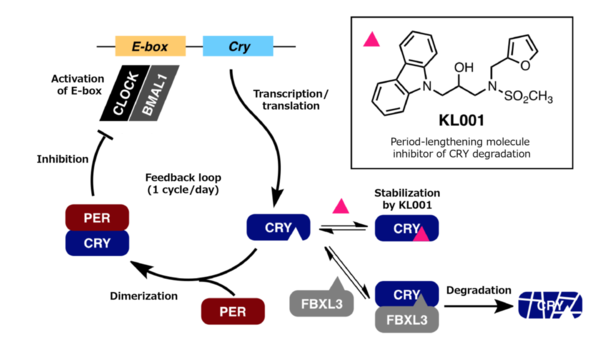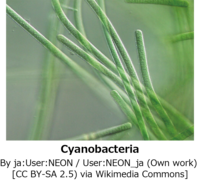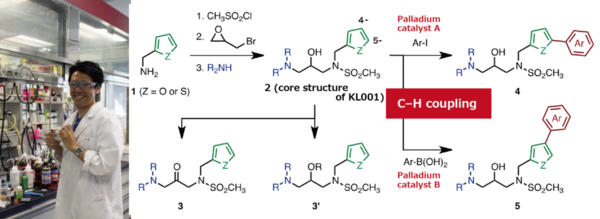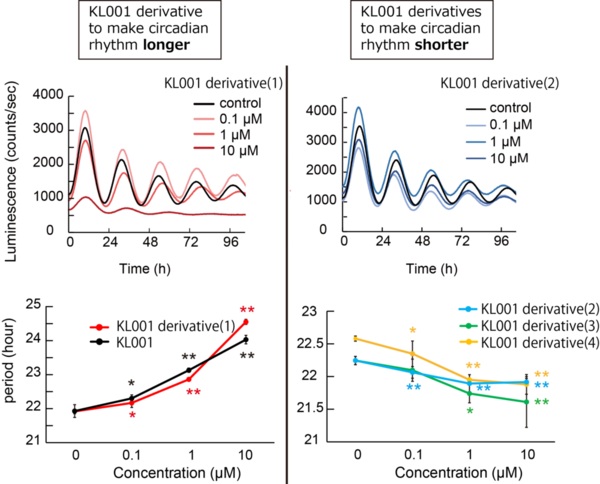Highlights
Highlights
A key to control the circadian rhythm lies in the molecules, revealed by interdisciplinary chemistry and biology research
- Read in Japanese
- ツイート
- 2015/11/27
- WPI-ITbM
- Graduate School of Science
- Graduate School of Bioagricultural Sciences
- Mr. Tsuyoshi Oshima (a graduate student)
- Dr. Iori Yamanaka
- Associate Prof. Junichiro Yamaguchi
- Associate Prof. Taeko Nishiwaki-Ohkawa
- Prof. Takashi Yoshimura
- Prof. Kenichiro Itami
Prof. Kenichiro Itami, Prof. Takashi Yoshimura, Prof. Steve Kay, and Prof. Stephan Irle along with their research groups at the Institute of Transformative Bio-Molecules (ITbM) at Nagoya University successfully discovered a unique molecule that can change the circadian rhythms in mammals. This study, using their unique and novel molecular catalytic approaches, became the first interdisciplinary achievement at ITbM, spanning the fields of synthetic chemistry, animal physiology, and computational chemistry. The results of this investigation are expected to contribute to victories over the various diseases related to the circadian rhythm and increased food production in the future.
This study was published online in Angewandte Chemie on May 8, 2015.→ Nagoya University Press Release
Taking advantage of the open and vibrant academic culture at Nagoya University, ITbM has achieved great results performed by young researchers through interdisciplinary research discussions. Here, we describe how the first "TbM" was born at ITbM.
"The molecule, what is it doing there?"
Prof. Kenichiro Itami, the director of ITbM at Nagoya University, encounters opportunities for innovation in a range of interdisciplinary academic fields. Despite the difficulties in communication that often makes it challenging for researchers from different academic backgrounds to share their interests or even to use a common vocabulary, a new research topic can be discovered in interdisciplinary discussions.
Especially after he started working at Nagoya University, Prof. Itami has appreciated many opportunities to initiate and advance collaborative research projects. One such project arose out of his interest in the circadian rhythms, which is a prominent ongoing research project at Nagoya University. While, pursuing the research, Prof. Itami noticed that studies of circadian rhythms have consistently involved research in biology but not in chemistry.
Motivated by a strong passion for introducing unique research on circadian rhythms to the field of chemistry, Prof. Itami met and spoke with Prof. Takashi Yoshimura, whose specialty is the circadian rhythms related to animal reproduction. They agreed to produce innovative and transformative bio-molecules that will solve urgent problems of worldwide importance at the interface of chemistry and biology. This led to the founding of ITbM in 2012 to start interdisciplinary research fields between chemistry and biology in the mixed laboratory.
Since then, the work demonstrating the new molecule that can change the circadian rhythms in mammals has produced the first result arising out of interdisciplinary studies at ITbM. Together, young researchers from different academic backgrounds perform experiments and discuss their results in the Mix Lab at ITbM; this leads to a highly encouraging atmosphere that further motivates their research activities. They look forward to obtaining their research results with their unique approaches.
*******
The circadian rhythm is the physiological phenomenon that leads to the one day cycle found in most organisms, such as animals, plants, fungi, and algae.
The understanding of the circadian system in prokaryote cyanobacteria has advanced considerably (cf. Kondo Lab., the Graduate School of Science at Nagoya University). On the other hand, the cells that form the various organs in animals, called eukaryotic cells, are significantly different from the prokaryote cells, as they have a nucleus protected with a nuclear membrane for each cell. Because of this complexity, the functioning of the circadian system in mammals has not been elucidated to the same degree as that in cyanobacteria.
“If molecules can modify the circadian clockwork in mammals to fast-forward,”
Prof. Yoshimura expects to increase the production of livestock during the seasonal breeding of animals. When day-time is short, as in the winter, many animals cannot breed because the testes’ size remains small. Therefore, if we can control the circadian clockwork to fast-forward or set it as short as the length of daytime, the testes will become sufficiently large to breed even during short daytime.
For mammals, four types of clock genes (Clock, Bmal1, Per, and Cry) and their clock proteins (CLOCK, BMAL1, PER, and CRY, respectively) are involved in circadian rhythm generation through transcription and translation feedback loop. Therefore, as seen in Figure 1, this feedback loop is cycled in one day, performing activation and inactivation: circadian rhythms can be controlled using molecules that manipulate the clock proteins.
 Figure 1.Feedback loop, performing activation and inactivation (Figure : by courtesy of Prof. Itami)
Figure 1.Feedback loop, performing activation and inactivation (Figure : by courtesy of Prof. Itami)
While not many molecules with such functionality have been reported, in 2012, Prof. Steve Kay and Designated Associated Prof. Tsuyoshi Hirota at ITbM discovered a molecule, KL001 (Figure 2) that lengthens the circadian rhythm directly acting on the clock protein, CRY. (Hirota, et al. Science (2012) 337: 1094-7)
“I am familiar with the structure of the molecule.”
Seeing the molecular structure of KL001, Prof. Itami was excited.
At that time, in 2012, certain questions were still unresolved such as which part of the structure in the KL001 molecule influences the circadian rhythm, and what kind of functionality can be added to the molecule. Therefore, the research group first attempted to elucidate the correlation between the structure and activity of KL001, and then sought to create new molecules that can control the circadian rhythm, setting it to either short or long cycles.
Copyright : Haruko Hirukawa, ITbM, Nagoya University
“I want to achieve something big!”
Mr. Tsuyoshi Oshima, currently in his 2nd year of the master’s program at the Graduate School of Science at Nagoya University, joined ITbM as the 1st enrolled student. Possessing a strong motivation to solve difficult problems, he enjoys his challenging work and is encouraged by his fellow lab members and the stimulating atmosphere.
Mr. Oshima started working with Associate Prof. Junichiro Yamaguchi and Dr. Kei Muto (at that time in his 3rd year of the Ph.D. program) from Prof. Itami’s research group. First, starting from a commercial product, he synthesized the KL001 core framework by three-step process. Searching for optimal synthesis parameters that would obtain higher yields, he performed the synthesis many times, gradually getting used to performing the synthesis by himself.
After obtaining high KL001 molecule yields, he performed the C–H coupling through the use of a palladium catalyst. He synthesized various KL001 derivatives changing the functional groups one by one: in total, more than 50 different derivatives of KL001 were generated out of much more than 200 KL001 synthesized molecules (Figure 3).
Figure 3. Left : Mr. Oshima@Laboratory. Right : Synthetic method to generate new molecules that change circadian rhythm (Figure : by courtesy of Prof. Itami)
—How are these KL001 derivatives activating the circadian rhythm?
Mr. Oshima from the chemistry department and Dr. Iori Yamanaka in Prof. Yoshimura’s research group from the biology department often had discussions to advance their research.
Each time Mr. Oshima synthesized the KL001 derivatives, they were given to Dr. Yamanaka and she checked the biologically functional parts of the KL001 derivative using human cultured cells through biological activity tests.
The cultured cell was prepared to contain the Bmal1 genes and a luminous enzyme, luciferase, connected to each other. The luminescence rhythm shows the transcription rhythm of the Bmal1 genes; therefore, by comparing the luminescence rhythms of the KL001 derivatives and a control sample, the changes in the circadian rhythm can be observed (Figure 4).
Figure 4. Left : KL001 derivative to make circadian rhythm longer <KL001 derivative(1)>. Right : KL001 derivatives to make circadian rhythm shorter <KL001 derivatives(2)-(4)>. (Figure : by courtesy of Dr. Yamanaka and Mr. Oshima)
“This KL001 derivative made the circadian rhythm shorter,” said Dr. Yamanaka to Mr. Oshima.
“How about this KL001 derivative then?” Mr. Oshima gave a new derivative to Dr. Yamanaka.
Then, Mr. Oshima and Dr. Yamanaka finally determined the components of the KL001 derivative with important functionalities.
Three important components were identified (Figure 5):
- A carbazole moiety (shown in blue in the figure) is essential for the biological activity.
- An amino alcohol moiety (shown in black in the figure) can be replaced with other substituents.
- A furan ring and a thiophene ring moiety (shown in green in the figure) change the length of the circadian rhythm by introducing substituents (shown in red in the figure) through C–H coupling.
Figure 5. The structure-activity correlation of the KL001 derivatives (Figure : by courtesy of Prof. Itami)
"This is an important and impressive start."
The structure-activity correlation of the KL001 derivatives provided an important hint for the research group, enabling them to create a new molecule that can change the circadian rhythm. Scientific understanding of the basic mechanisms is the first step for the practical use of this molecule, for example, for the control of diseases related to the circadian rhythm such as insomnia.
*******
Their mentors are pleased with the young researchers’ achievement.
“Dr. Yamanaka could accurately produce the research results because of her careful experiments.”
Associate Prof. Taeko Nishiwaki-Ohkawa from Prof. Yoshimura’s group explained that cells must be handled carefully to maintain them in good condition; otherwise, the experiments are meaningless. Excellent biologists know the conditions of the cells.
“Mr. Oshima is a hard worker, so he produced the research results in a short time.”
Associate Prof. Yamaguchi from Prof. Itami’s group was impressed with Mr. Oshima’s attitude toward the research. He identifies an original research problem and then solves it as he is so interested in it. He also volunteers to set up the research environment.
In addition, there is no need to open the doors between the laboratories. They can have discussions frequently “just there” in the Mix Lab.
—New molecules are, now also, continuously born there.
(Ayako Umemura)
Researchers featured in this article
 From the Left: Prof. Itami, Associate Prof. Yamaguchi, Dr. Kumar, Prof. Yoshimura, Mr. Oshima, Prof. Irle, Dr. Yamanaka, and Associate Prof. Nishiwaki-Ohkawa.
From the Left: Prof. Itami, Associate Prof. Yamaguchi, Dr. Kumar, Prof. Yoshimura, Mr. Oshima, Prof. Irle, Dr. Yamanaka, and Associate Prof. Nishiwaki-Ohkawa.
Dr. Kenichiro Itami【Professor, Institute of Transformative Bio-Molecules (WPI-ITbM), Nagoya University】
Dr. Itami graduated from the Department of Synthetic Chemistry, School of Engineering, Kyoto University in 1994 and obtained a doctorate degree in engineering at Kyoto University in 1998. He, then, worked as Assistant Professor at the Department of Synthetic Chemistry and Biological Chemistry, Graduate School of Engineering, Kyoto University. Dr. Itami moved to the Research Center for Materials Science (RCMS), Nagoya University, in 2005 to work as Associate Professor. In 2008, he became Full Professor in the Department of Chemistry, Graduate School of Science at Nagoya University. In addition, since 2013, Dr. Itami has been the Director of WPI-ITbM and a project leader of the JST-ERATO Itami Molecular Nanocarbon Project.
Prof. Itami has received many awards during his career:
Fellow of the Royal Society of Chemistry, UK (2012);
Mukaiyama award (2013);
Novartis Chemistry Lectureship Award (2013);
The JSPS Prize (2014);
Arthur C. Cope Scholar Award (2015); and many more.
***
Dr. Itami, the big boss of large research groups, identifies challenging problems in enjoyable conversations. Because of his charismatic personality, he has many fans in the broader local society as well, in fact attracting high school students to study at ITbM.
His word, “Nagoya Boro-Gachi! (convincing victory for Nagoya!),” have brought together many young researchers. I am looking forward to his research group’s further achievements (by AU)
Dr. Takashi Yoshimura【Professor, Institute of Transformative Bio-Molecules (WPI-ITbM), Nagoya University】
In 1993, Dr. Yoshimura graduated from the School of Agriculture at Nagoya University, and in 1995, he completed his master's degree in the Graduate School of Agriculture at Nagoya University. Between April 1995 and September 1996, Dr. Yoshimura pursued his research during his doctoral course as a fellow of the Japan Society for the Promotion of Science (DC1). After the course, he started working as an assistant professor at the same school. In 2005, Dr. Yoshimura became an associate professor at the Graduate School of Bioagricultural Sciences, Nagoya University, and subsequently became a professor in 2008. From 2008 to 2011, Dr. Yoshimura served as a director of the Avian Bioscience Research Center, Nagoya University. In 2013, he started working at the Institute of Transformative Bio-Molecules (WPI-ITbM), Nagoya University. Concurrently, he assumed the position of professor at the Graduate School of Bioagricultural Sciences and the position of visiting professor at the National Institute for Basic Biology.
Prof. Yoshimura has received many awards during his career:
Academic Award; Japanese Society for Chronobiology (Nov. 2004);
Japan Prize in Agricultural Sciences, Achievement Award for Young Scientists; The Foundation of Agricultural Sciences of Japan (Nov. 2005);
JSPS Prize; Japan Society for the Promotion of Science (Mar. 2009);
Japanese Society of Animal Science Award (Mar. 2009);
Hoffenberg International Medal; Society for Endocrinology (Mar. 2010);
Van Meter Award; American Thyroid Association (Oct. 2015).
***
Research atmosphere can be influenced by cultural background. However, “we are not worried about such a cultural shock at ITbM,” said Dr. Yoshimura. A welcoming atmosphere is generated even by top researchers in other fields.
Dr. Yoshimura gets excited by new ideas presented by new people. I believe that his unique way of thinking will influence young researchers (by AU)
Dr. Junichiro Yamaguchi【Associate Professor, Graduate School of Science, Nagoya University】
Dr. Yamaguchi graduated from the Department of Industrial Chemistry in the Faculty of Engineering, Tokyo University of Science, in 2002. During his doctoral course, he became a fellow of the Japan Society for the Promotion of Science (JSPS) in 2004, and through studying abroad at the Department of Chemistry in the Scripps Research Institute (TSRI) in 2005, obtained his doctorate degree in engineering from the Tokyo University of Science in 2007. Dr. Yamaguchi then moved to TSRI to work as a JSPS postdoctoral fellow, and in 2008, he started working as an assistant professor, and then as an associate professor in 2012 in the Department of Chemistry, School of Science, Nagoya University. Between August and September 2012, Dr. Yamaguchi concurrently researched as a visiting associate professor at Münster University. In addition, since 2013, he has been advancing his research as a cooperating researcher at ITbM, Nagoya University.
Associate Prof. Yamaguchi has received many awards during his career:
ITbM Research Award (2013);
Banyu Chemist Award (BCA) (2013);
Thieme Chemistry Journal Award (2014);
Asian Core Lectureship Award, China (2014);
Asian Core Lectureship Award, Thailand (2014); and many more.
***
Dr. Yamaguchi is a researcher and a mentor, and a representative of Chem Station. He has performed a lot of tasks owing to his spirit, challenging the “unprecedented.”
With unique ideas and approaches, Dr. Yamaguchi expects that many research achievements will be produced at ITbM with unique ideas and approaches. I will happily come back to hear about other research results as well (by AU)
Dr. Taeko Nishiwaki-Ohkawa【Associate Professor, Graduate School of Bioagricultural Sciences, Nagoya University】
Dr. Nishiwaki-Ohkawa obtained her Ph.D. title in Science from Sokendai (the Graduate University for Advanced Studies). She then moved to the Division of Biological Science at the Graduate School of Science at Nagoya University as a postdoctoral researcher and then as a designated lecturer for the research topic of the oscillation mechanism of circadian rhythms in cyanobacteria. In 2013, she became a designated associate professor at ITbM. Since 2015, she has also been an associate professor at the Graduate School of Bioagricultural Sciences.
Associate Prof. Nishiwaki-Ohkawa has received an award during her career:
ITbM Research Award (2013)
***
Dr. Nishiwaki-Ohkawa told me that she has been interested in the interdisciplinary field of ecology and physics since she attended the circadian rhythm symposium when she was a student. In fact, she was attracted to research in various scientific fields, and hence she became a researcher.
Based on her research career in cyanobacteria, her current challenge is to focus on mammals using chemistry resources at ITbM. I expect to hear about her further achievements in the near future (by AU)
Dr. Iori Yamanaka【Postdoctoral Researcher, Institute of Transformative Bio-Molecules (WPI-ITbM), Nagoya University】
Dr. Yamanaka graduated from the Division of Biological Science at the School of Science, Nagoya University, and then completed her master’s program at the Graduate School of Science, Nagoya University. She began her research during her doctoral course at the Graduate School of Science, Nagoya University, as a JSPS DC1. Since obtaining her Ph.D. in science in 2013, she has been at her current position at ITbM.
***
“Quality is more important than quantity,” Dr. Yamanaka has developed the skills to efficiently and accurately perform experiments. This is highly important for making unprecedented discoveries.
In the world of biological research, the target materials are alive and their health conditions influence the research results. During the interview, Dr. Yamanaka impressed me with such an alive world. I look forward to her further success in research (by AU)
Mr. Tsuyoshi Oshima【Graduate student, Graduate School of Science, Nagoya University】
Mr. Oshima graduated from the Department of Chemistry at the School of Science, Nagoya University in 2014. Currently, he is a graduate student in the Department of Chemistry at the Graduate School of Science at Nagoya University.
Mr. Tsuyoshi Oshima has received an award during his career:
Poster Award, 10th Annual Meeting of Japanese Society for Chemical Biology (2015)
***
He can make greater efforts owing to the encouragement by his fellow laboratory members, said Mr. Oshima. Despite his smile and gentle personality, during our conversation in, I felt his independence and strength have enabled him to overcome the challenges of research.
He is still a 2nd year master’s student. I have no doubt that he will be successful in the future (by AU)
Links
- Institute of Transformative Bio-Molecules (WPI-ITbM) HP http://www.itbm.nagoya-u.ac.jp/
- Department of Chemistry, Graduate School of Science, Nagoya University HP http://www3.chem.nagoya-u.ac.jp/wordpress/?lang=en
- Laboratory of Animal Physiology HP https://www.agr.nagoya-u.ac.jp/~aphysiol/e-index.html
- Kondo Lab. Biochronometry Group HP http://clock.bio.nagoya-u.ac.jp/e/index.htm
- Link to this article (from a search-result)
http://onlinelibrary.wiley.com/doi/10.1002/anie.201502942/abstract
Tsuyoshi Oshima,Iori Yamanaka, Anupriya Kumar, Junichiro Yamaguchi, Taeko Nishiwaki-Ohkawa, Kei Muto, Rika Kawamura, Tsuyoshi Hirota, Kazuhiro Yagita, Stephan Irle, Steve A. Kay, Takashi Yoshimura, and Kenichiro Itami.
C—H Activation Generates Period-Shortening Molecules That Target Cryptochrome in the Mammalian Circadian Clock.
Angew. Chem. Int. Ed. 54: 7193 (2015).
(First published on May 8, 2015; doi: 10.1002/anie.201502942)
- Link to related article (from a search-result)
http://www.sciencemag.org/content/337/6098/1094.full
Tsuyoshi Hirota, Jae Wook Lee, Peter C. St. John, Mariko Sawa, Keiko Iwaisako, Takako Noguchi, Pagkapol Y. Pongsawakul, Tim Sonntag, David K. Welsh, David A. Brenner, Francis J. Doyle III, Peter G. Schultz, Steve A. Kay.
Identification of Small Molecule Activators of Cryptochrome.
Science. 337: 1094 (2012).
(First published on August 31, 2012; doi: 10.1126/science.1223710)
NU Research
(English)








